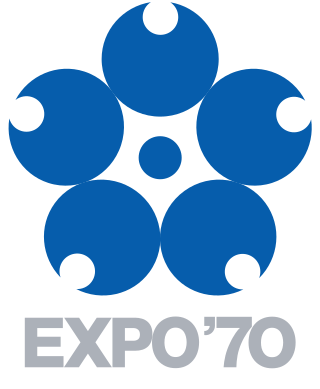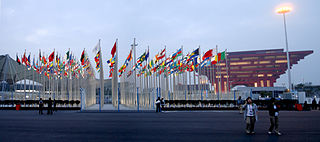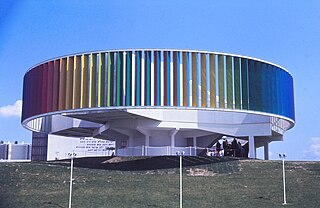
The 1967 International and Universal Exposition, commonly known as Expo 67, was a general exhibition from April 28 to October 27, 1967. It was a category one world's fair held in Montreal, Quebec, Canada. It is considered to be one of the most successful World's Fairs of the 20th century with the most attendees to that date and 62 nations participating. It also set the single-day attendance record for a world's fair, with 569,500 visitors on its third day.

Expo 2000 was a World Expo held in Hanover, Germany from 1 June to 31 October 2000. It was located on the Hanover Fairground, which is the largest exhibition ground in the world. Initially some 40 million people were expected to attend the exhibition over the course of months; however, eventually with less than half of this number, the Expo was a flop and turned out to be a financial failure.

The Japan World Exposition, Osaka, 1970 or Expo 70 was a world's fair held in Suita, Osaka Prefecture, Japan between March 15 and September 13, 1970. Its theme was "Progress and Harmony for Mankind." In Japanese, Expo '70 is often referred to as Ōsaka Banpaku (大阪万博). It was the first world's fair held in Japan and in Asia.

The Montreal Casino, located in Montreal, Quebec, is the largest casino in Canada. Situated on Notre Dame Island, in Jean-Drapeau Park, it consists of two former Expo 67 pavilion buildings. The casino is open to the public seven days a week, operating morning until late night. It first opened on October 9, 1993.

Notre Dame Island is an artificial island in the Saint Lawrence River in Montreal, Quebec, Canada. It is immediately to the east of Saint Helen's Island and west of the Saint Lawrence Seaway and the city of Saint-Lambert on the south shore. Together with Saint Helen's Island, it makes up Parc Jean-Drapeau, which forms part of the Hochelaga Archipelago. To the southeast, the island is connected to the embankment separating the seaway and Lachine Rapids.
Frei Paul Otto was a German architect and structural engineer noted for his use of lightweight structures, in particular tensile and membrane structures, including the roof of the Olympic Stadium in Munich for the 1972 Summer Olympics.

The Biosphere, also known as the Montreal Biosphere, is a museum dedicated to the environment in Montreal, Quebec, Canada. It is housed in the former United States pavilion constructed for Expo 67 located within the grounds of Parc Jean-Drapeau on Saint Helen's Island. The museum's geodesic dome was designed by Buckminster Fuller.
Colin Vaughan was an Australian-born Canadian television journalist, architect, urban activist and alderman serving the city of Toronto, Ontario, Canada. He was best known as the political specialist for the Toronto television station Citytv from 1977 until his death. He died suddenly of a heart attack at the age of 68.

Roderick George Robbie was a British-born Canadian architect and planner. He was known for his design of the Canadian Pavilion at Expo 67 and Toronto's Rogers Centre (SkyDome).

The Seville Expo '92 was a universal exposition that took place from Monday, April 20 to Monday, October 12, 1992, on La Isla de La Cartuja, Seville, Spain. The theme for the expo was "The Age of Discovery", celebrating the 500th anniversary of Christopher Columbus reaching the Americas after launching from Seville's port, and over 100 countries were represented. The total amount of land used for the expo was 215 hectares and the total number of visitors was 41,814,571. The exposition ran at the same time as the smaller and shorter-duration Genoa Expo '92, a Specialized Exhibition, held in memory of Christopher Columbus, born in Genoa.

La Ronde is an amusement park in Montreal, Quebec, Canada, built as the entertainment complex for Expo 67, the 1967 World Fair. Today, it is operated by Six Flags under an emphyteutic lease with the City of Montreal, which expires in 2065. It is the largest amusement park in Quebec and second largest in Canada.

The Expo 67 International and Universal Exposition featured 90 pavilions representing Man and His World, on a theme derived from Terre des Hommes, written by the famous French pilot Antoine de Saint-Exupéry.
Hazen E. Sise (1906–1974) was a Canadian architect, educator, and humanitarian.

The 1986 World Exposition on Transportation and Communication, or simply Expo 86, was a World's Fair held in Vancouver, British Columbia, Canada from May 2 until October 13, 1986. The fair, the theme of which was "Transportation and Communication: World in Motion – World in Touch", coincided with Vancouver's centennial and was held on the north shore of False Creek.

This article contains the details of the pavilions at Expo 2010. The 2010 World Expo Shanghai is the largest Expo site ever, covering more than 5.2 square kilometers and containing more than 70 exposition pavilions. More than 190 countries and 50 international organizations registered to participate in the 2010 Shanghai Expo. After the six-month run, the Expo had attracted well over 70 million visitors. The Expo 2010 is also the most expensive fair in the history of the World's Fair, with more than 45 billion US dollars invested by the Chinese Government.

The Québec Pavilion was a pavilion at Expo 67 in Montreal on Notre Dame Island. It featured modern architecture and exhibited Quebec's urban and industrial growth.
Canada '67 is a Circle-Vision 360° documentary film by Canadian film director Robert Barclay, which was presented at the Telephone Pavilion,, part of Expo 67, an International World's Fair held in Montreal, Quebec, Canada in 1967 to mark the centenary of the Confederation of Canada.
Arcop was an architectural firm based in Montreal, renowned for designing many major projects in Canada including Place Bonaventure, Place Ville-Marie and Maison Alcan. The firm was originally formed as a partnership under the name Affleck, Desbarats, Lebensold, Michaud & Sise between Ray Affleck, Guy Desbarats, Jean Michaud, Fred Lebensold and Hazen Sise, all graduates and/or professors at the McGill School of Architecture. In 1959, after the departure of Michaud and the addition of Dimitri Dimakopoulos, another McGill Architecture graduate, the firm was renamed Affleck, Desbarats, Dimakopoulos, Lebensold, Sise which it maintained for a decade afterward. The company did not adopt the name Arcop, which stands for "Architects in Co-Partnership", until 1970.

The Kaleidoscope Pavilion was a sponsored pavilion at Expo 67, the International World's Fair held in Montreal, Quebec, Canada in 1967.















